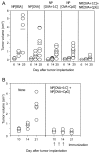Induction of Potent Antigen-specific Cytotoxic T Cell Response by PLGA-nanoparticles Containing Antigen and TLR Agonist
- PMID: 23559898
- PMCID: PMC3607708
- DOI: 10.4110/in.2013.13.1.30
Induction of Potent Antigen-specific Cytotoxic T Cell Response by PLGA-nanoparticles Containing Antigen and TLR Agonist
Abstract
Previously we showed that biodegradable nanoparticles containing poly-IC or CpG oligodeoxynucleotide (ODN) together with ovalbumin (OVA) were efficient at inducing MHC-restricted presentation of OVA peptides in dendritic cells. The CTL-inducing activities of the nanoparticles were examined in the present study. Nanoparticles containing poly-IC or CpG ODN together with OVA were prepared using biodegradable polymer poly(D,L-lactic acid-co-glycolic acid), and then were opsonized with mouse IgG. The nanoparticles were injected into the tail vein of mice, and 7 days later the OVA-specific CTL activities were measured using an in vivo CTL assay. Immunization of mice with the nanoparticles containing poly-IC or CpG ODN together with OVA elicited potent OVA-specific CTL activity compared to those containing OVA only. In accordance with these results, nanoparticles containing poly-IC or CpG ODN together with OVA exerted potent antitumor activity in mice that were subcutaneously implanted with EG7.OVA tumor cells. These results show that encapsulation of poly-IC or CpG ODN together with antigen in biodegradable nanoparticles is an effective approach for the induction of potent antigen-specific CTL responses in vivo.
Keywords: Antitumor activity; CTL; CpG; Nanoparticle; PLGA; Poly-IC.
Conflict of interest statement
The authors declare no financial or commercial conflicts of interest.
Figures


Similar articles
-
Biodegradable nanoparticles containing TLR3 or TLR9 agonists together with antigen enhance MHC-restricted presentation of the antigen.Arch Pharm Res. 2010 Nov;33(11):1859-66. doi: 10.1007/s12272-010-1119-z. Epub 2010 Nov 30. Arch Pharm Res. 2010. PMID: 21116790
-
Co-delivery of Dual Toll-Like Receptor Agonists and Antigen in Poly(Lactic-Co-Glycolic) Acid/Polyethylenimine Cationic Hybrid Nanoparticles Promote Efficient In Vivo Immune Responses.Front Immunol. 2017 Sep 13;8:1077. doi: 10.3389/fimmu.2017.01077. eCollection 2017. Front Immunol. 2017. PMID: 28955328 Free PMC article.
-
Polymer nanoparticles for cross-presentation of exogenous antigens and enhanced cytotoxic T-lymphocyte immune response.Int J Nanomedicine. 2016 Aug 5;11:3753-64. doi: 10.2147/IJN.S110796. eCollection 2016. Int J Nanomedicine. 2016. PMID: 27540289 Free PMC article.
-
Co-encapsulated CpG oligodeoxynucleotides and ovalbumin in PLGA microparticles; an in vitro and in vivo study.J Pharm Pharm Sci. 2014;17(4):541-53. doi: 10.18433/j33892. J Pharm Pharm Sci. 2014. PMID: 25579433
-
Particulate formulations for the delivery of poly(I:C) as vaccine adjuvant.Adv Drug Deliv Rev. 2013 Oct;65(10):1386-99. doi: 10.1016/j.addr.2013.05.013. Epub 2013 Jun 7. Adv Drug Deliv Rev. 2013. PMID: 23751781 Review.
Cited by
-
Peptide/protein vaccine delivery system based on PLGA particles.Hum Vaccin Immunother. 2016 Mar 3;12(3):806-28. doi: 10.1080/21645515.2015.1102804. Hum Vaccin Immunother. 2016. PMID: 26513024 Free PMC article. Review.
-
Harnessing Dendritic Cells for Poly (D,L-lactide-co-glycolide) Microspheres (PLGA MS)-Mediated Anti-tumor Therapy.Front Immunol. 2019 Apr 5;10:707. doi: 10.3389/fimmu.2019.00707. eCollection 2019. Front Immunol. 2019. PMID: 31024545 Free PMC article. Review.
-
Nano-based approaches in the development of antiviral agents and vaccines.Life Sci. 2021 Jan 15;265:118761. doi: 10.1016/j.lfs.2020.118761. Epub 2020 Nov 12. Life Sci. 2021. PMID: 33189824 Free PMC article. Review.
-
Biodegradable Polymeric Nanoparticles-Based Vaccine Adjuvants for Lymph Nodes Targeting.Vaccines (Basel). 2016 Oct 12;4(4):34. doi: 10.3390/vaccines4040034. Vaccines (Basel). 2016. PMID: 27754314 Free PMC article. Review.
-
Human Salivary Histatin-1-Functionalized Gelatin Methacrylate Hydrogels Promote the Regeneration of Cartilage and Subchondral Bone in Temporomandibular Joints.Pharmaceuticals (Basel). 2021 May 19;14(5):484. doi: 10.3390/ph14050484. Pharmaceuticals (Basel). 2021. PMID: 34069458 Free PMC article.
References
-
- Van Der Bruggen P, Zhang Y, Chaux P, Stroobant V, Panichelli C, Schultz ES, Chapiro J, Van Den Eynde BJ, Brasseur F, Boon T. Tumor-specific shared antigenic peptides recognized by human T cells. Immunol Rev. 2002;188:51–64. - PubMed
-
- Huang AY, Golumbek P, Ahmadzadeh M, Jaffee E, Pardoll D, Levitsky H. Role of bone marrow-derived cells in presenting MHC class I-restricted tumor antigens. Science. 1994;264:961–965. - PubMed
-
- Harding CV. Phagocytic processing of antigens for presentation by MHC molecules. Trends Cell Biol. 1995;5:105–109. - PubMed
-
- Sigal LJ, Crotty S, Andino R, Rock KL. Cytotoxic T-cell immunity to virus-infected non-haematopoietic cells requires presentation of exogenous antigen. Nature. 1999;398:77–80. - PubMed
-
- Heath WR, Carbone FR. Cross-presentation, dendritic cells, tolerance and immunity. Annu Rev Immunol. 2001;19:47–64. - PubMed
LinkOut - more resources
Full Text Sources
Other Literature Sources
Research Materials

